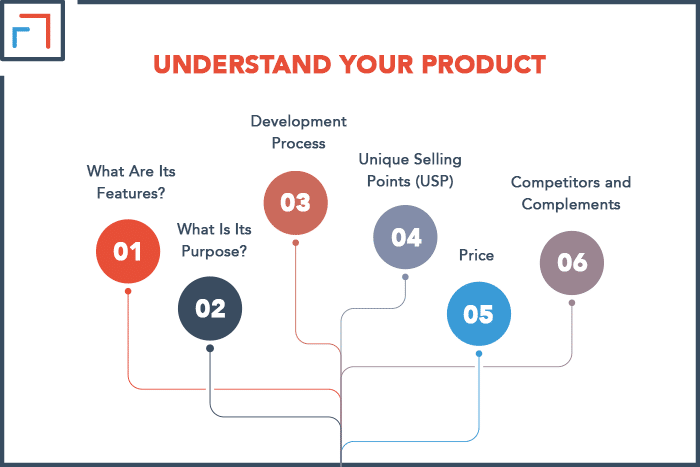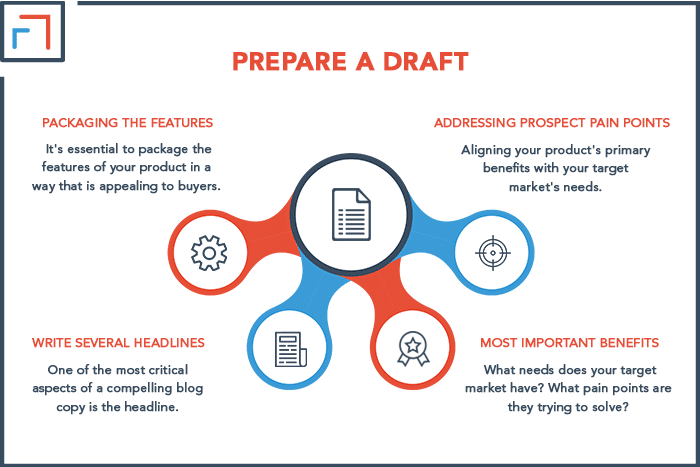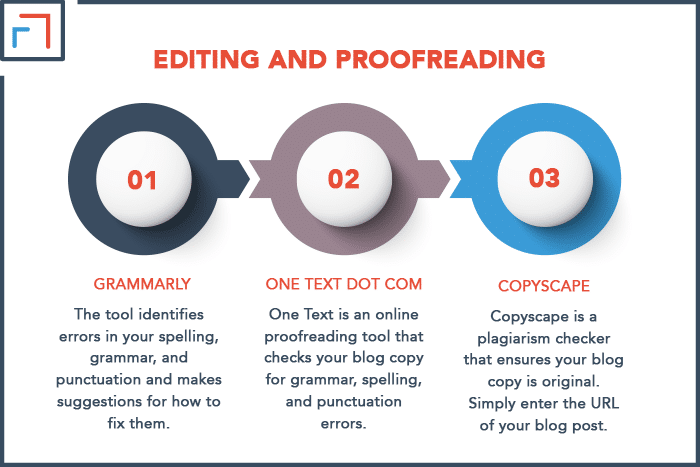Copywriting for blogs is different from copywriting for other mediums. The tone of a blog post should be informal and conversational, as if you were talking to a friend. But that is easier said than done. Copywriting is a skill that takes time and practice to perfect.
To copywrite for blogs, you need to understand your product. After that, prepare a draft that presents the features and benefits. Next, write your content, headlines, and subheadings. Finally, edit and proofread before publishing. After a few days, review your post and track its performance.
Now that we have an overview of how to copywrite for blogs let’s get into the nitty-gritty. There are some best practices you should follow when copywriting.
Step-by-step Guide to Write a Blog Copy
Any project that doesn’t have a plan behind it is likely to fail. So before we start typing away, it’s essential to understand the copywriting process for blogs.
1. Understand Your Product
The genesis of any copywriting project is understanding what you are selling. This might sound like a no-brainer, but it’s worth repeating.
You need to know your product inside and out before you can write about it. Buyers are more likely to lend you an ear if you’re an authority on the subject. Before anything else, do your research.
To help you know your product better, here are some questions you can ask yourself:

a. What Are Its Features?
The benefits of a product come from its features. Try to write a list of all the qualities/features of your product before moving on to anything else.
The features will give you an idea of what the product can do. It’s your job to turn those features into benefits that resonate with your target market.
b. What Is Its Purpose?
Most people don’t buy a product solely because of its features. Instead, they purchase it to solve a problem or to get a specific result. Therefore, it’s essential to understand the purpose of your product.
Blog copy that focuses on the purpose of a product is usually more successful. After all, buyers are looking for solutions to their problems.
Your job as a copywriter is to show your target market how your product can help them solve their problem. If you can do that, you’re well on your way to writing an effective blog post.
To better understand the purpose of your product, ask yourself these questions:
- Who is the target market?
- What problem does this product solve?
- What result does this product deliver?
c. Development Process
Now, more than ever, buyers are interested in the development process of a product. They want to know how a product is made and what goes into it.
Issues like sustainability and support for local businesses are important to many buyers. If your product is made ethically, be sure to highlight that in your blog copy.
Try to mention the quality checks and safety procedures you have in place as well. If your product is made with only the highest quality materials, ensure your target market knows that.
d. Unique Selling Points (USP)
When copywriting, you should ask yourself, “What makes my product unique?”
The unique selling points will make your product stand out in a sea of similar items. It’s important to remember that buyers are looking for the best bang for their buck.
To write a persuasive blog copy, you need to find and highlight the unique selling points of your product.
Some examples of unique selling points are:
- A money-back satisfaction guarantee
- Free shipping
- A loyalty program
e. Price
The price is another crucial aspect of your product. It’s essential to be transparent about the pricing of your product from the get-go. Buyers are always looking for a good deal.
Therefore, ensure they know what they’re getting into. When you’re writing persuasive blog copy, you should be able to answer these questions:
- Is the price fair?
- Is the product worth its price?
- What payment options do I have?
f. Competitors and Complements
As a copywriter, you should understand the competitive landscape.
What are other companies selling? How are they selling it? Look at the ways they advertise their products and see if there’s anything you want to emulate or change.
It’s also important to know about complementary products. For example, if you’re selling a camera, your customer might need to buy additional items to use your product.
For example, maybe they would need a tripod or a memory card. Answering these questions will help you position your product in a way that makes it more appealing to buyers.
Now that you understand your product better, it’s time to start writing!
2. Prepare a Draft
There is a famous quote from Abraham Lincoln: “If I had five minutes to chop down a tree, I’d spend the first three sharpening my axe. “
The same can be said about writing a blog copy. The better prepared you are, the easier it will be to write a persuasive copy.
To prepare a blog post draft, start by brainstorming a list of ideas. What topics do you want to cover? What points do you want to make?
Once you have a list of ideas, start fleshing them out into complete sentences. Don’t worry about being perfect at this stage. Just get your ideas down on paper (or screen).
You can always go back and edit later. Here are a few points to help you create a good draft for your blog copy.

a. Packaging the Features
When you’re writing copy, it’s essential to package the features of your product in a way that is appealing to buyers. Remember, buyers are looking for solutions to their problems.
To do this, start by listing the features of your product. Then, for each feature, answer the question: “What benefit does this provide to the buyer?”
For example, let’s say you’re selling a new type of vacuum cleaner. The features of your product might be:
- A powerful motor
- An ergonomic design
- A detachable hose
To package these features in a way that is appealing to buyers, you would write something like this:
“Our vacuum cleaner has a powerful motor that will make short work of even the dirtiest floors. The ergonomic design means it’s easy to use and won’t cause fatigue.
And the detachable hose makes it easy to clean hard-to-reach places.”
b. Most Important Benefits
Once you’ve packaged the features of your product, it’s time to focus on the most important benefits.
What are the most important benefits of your product? To answer this question, start by thinking about what your target market is looking for.
What needs does your target market have? What pain points are they trying to solve? Once you’ve answered these questions, you’ll identify the most important benefits of your product.
The purpose of identifying the primary benefits is to help you focus your copy. Keep these benefits in mind when writing and ensure they are front and center.
c. Addressing Prospect Pain Points
Aligning your product’s primary benefits with your target market’s needs is a great way to write a blog copy.
If you can address their pain points in your copy, you’ll be more likely to convince them to buy from you.
To do this effectively, start by identifying the needs of your target market. Chances are, they have specific problems that need to be solved.
You can help them feel seen if you specifically identify their issues in your copy and provide solutions.
For example, let’s say you’re selling a new type of skincare product. In this example, your target market might be people who have sensitive skin. Some of the needs of your target market would be:
- To find a skincare product that won’t irritate the skin
- Getting a gentle and effective skincare product
- To find a skincare product for everyday use
You can address these needs in your copy by writing something like this in your draft: “Our skincare product is perfect for people with sensitive skin.
It’s gentle and effective and can be used every day without causing irritation.”
d. Write Several Headlines
One of the most critical aspects of a compelling blog copy is the headline. A good headline will grab the attention of your prospects and convince them to keep reading.
More than 80% of all your readers will only read your headline. So it’s essential to spend time crafting headlines that are both attention-grabbing and relevant to your target market.
A good rule of thumb is to write at least five headlines for each blog copy. This may seem like a lot, but having too many options is better than not enough.
Your first draft is not always your best, so try a variety of tactics and formats. Once you’ve written your headlines, it’s time to move on to the body of your blog copy.
3. Writing Blog Copy
Everything you’ve done up to this point has led to the writing of your blog copy.
Now it’s time to put all that preparation to work and write something that’s both attention-grabbing and persuasive.
When you’re writing a blog copy, keep the following elements in mind:
a. Title
Each day, over 2 million blog posts are published on WordPress alone. So if you want your blog copy to stand out, you need an attention-grabbing title.
The clicks on your title determine whether or not people will read your blog copy. Ensure your headlines are relevant to your target market and accurately reflect the content of your blog post.
A good blog copy title should:
- Be as specific as possible
- Use strong language
- Be between six and twelve words long
- Use numbers or lists whenever possible
b. Subheadings
Once you’ve grabbed the attention of your target market with a strong title, you must provide structure and order with subheadings.
Subheadings help to break up large blocks of text and make your blog copy easier to read. They also give readers a clear idea of what to expect from each section of your blog post.
When writing subheadings, ensure they accurately reflect each section’s content and are relevant to your target market. Don’t wander off-topic because this will frustrate and confuse readers.
c. Paragraphs
If headings and subheadings make up the skeleton of your blog post, the paragraphs are the meat.
When writing paragraphs, keep the following tips in mind:
- Keep them short – Ideally, each paragraph should be between 3-5 sentences long.
- Make them scannable – Use short sentences and plenty of white space to make your paragraphs easy to scan.
- Use strong language – Use persuasive language to convince your readers that your product is the best solution to their problem.
An essential part of copywriting for blogs is to focus on your target market’s needs. By understanding what they need and addressing those needs in your blog copy, you’ll write a conversion masterpiece.
4. Editing and Proofreading
There is a big difference between an edited and unedited piece of writing.
First impressions matter, and if your blog copy is full of spelling and grammatical errors, it will not make a good impression on your target market.
Before you hit publish, take some time to edit and proofread your blog copy. Here are some tools that will help you to do just that. Just remember, they are not substitutes for a human editor.
a. Grammarly
This grammar checker helps you to identify and correct any errors in your blog copy. You can use the free version or upgrade to premium for more features.
The tool identifies errors in your spelling, grammar, and punctuation and makes suggestions for how to fix them.
Apart from that, Grammarly helps you rectify your sentence structure, choose better words, and avoid plagiarism.
b. One Text Dot Com
One Text is an online proofreading tool that checks your blog copy for grammar, spelling, and punctuation errors. It also gives you suggestions for how to improve your writing.
One Text is an excellent option if you want a free proofreading tool. However, it’s important to note that the tool doesn’t catch everything.
You’ll still need to do a final read-through of your blog post before you publish it.
c. Copyscape
Copyscape is a plagiarism checker that ensures your blog copy is original. Simply enter the URL of your blog post, and Copyscape will scan the internet for any instances of copied content.
If you’re using someone else’s work in your blog post, be sure to attribute it properly. Copyscape will also help you check that quotes or attributions are correctly cited.

5. Monitor Your Blog’s Performance
You can only determine your blog post’s effect once it has been published. Take some time to read through the post and see how it’s been received by your target market.
If you’re not happy with the response, consider making some changes to improve engagement.
For example, you could add more images or videos, break up your text with subheadings, or add interactive elements like polls or quizzes.
Most importantly, don’t be afraid to experiment. The only way to get better at copywriting for blogs is to keep writing and learn from your mistakes.
With time and practice, you’ll hone your skills and produce copy that is both informative and persuasive.
Wrapping Up
Although you can’t produce a perfect copy for a blog on the first try, you can improve your skills by practicing and following some simple tips.
To be a good blog copywriter, you must understand your product well and package the features in an interesting way. Write catchy headlines that make the reader want to know more.
Finally, don’t forget to edit and proofread your work before you publish it. Following these steps will improve the quality of your blog posts and help you engage more readers.
